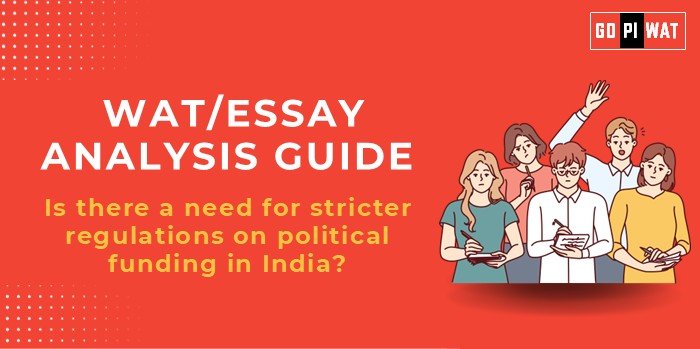📋 WAT/Essay Analysis Guide: Is There a Need for Stricter Regulations on Political Funding in India?
🌟 Understanding the Topic’s Importance
Political funding is the lifeblood of democratic elections, but its opaque nature in India raises questions about fairness, equity, and accountability. For B-school students, analyzing this topic provides a platform to explore critical issues in governance, ethics, and policy design, which are integral to leadership roles in public or corporate sectors.
⏳ Effective Planning and Writing
- 📝 Time Allocation:
- Planning: 5 minutes
- Writing: 20 minutes
- Reviewing: 5 minutes
- 📚 Preparation Tips:
- Gather verified statistics such as the scale of anonymous donations and examples of global best practices.
- Identify the roles of stakeholders like the Election Commission of India (ECI), political parties, and NGOs.
- Develop a nuanced understanding of comparative regulatory frameworks in countries like the US and UK.
📖 Introduction Techniques
- ⚖️ Contrast Approach: “While India is celebrated as the world’s largest democracy, the opacity of its political funding mechanisms undermines the ideals of transparency and equity.”
- 💡 Solution-Based Opening: “Stronger regulations on political funding are essential for fostering a fair democratic process, curbing corruption, and ensuring accountability in India’s electoral system.”
📚 Structuring the Essay Body
1. Achievements:
- ✔️ Electoral Bonds: Introduced in 2018, they aimed to reduce unaccounted cash donations but have faced criticism for lacking full transparency.
- ✔️ Role of the Election Commission: Active monitoring of candidate expenditure provides a foundation for further reforms.
2. Challenges with Comparative Analysis:
- ⚠️ Opacity in Funding: More than 50% of political funding remains undisclosed, unlike in the UK, where all donations over £7,500 are reported publicly.
- ❌ Lack of RTI Coverage: Indian political parties are not subject to RTI scrutiny, whereas US donors must adhere to Federal Election Commission (FEC) regulations.
3. Future Outlook:
- 🌟 Digitalize donation channels to ensure traceability of all donations.
- 💡 Explore public funding models to reduce reliance on private donors and level the playing field for smaller parties.
🔚 Concluding Effectively
- 🌀 Balanced Conclusion: “India’s journey toward transparent political funding has witnessed partial successes, such as the introduction of electoral bonds. However, comprehensive frameworks are imperative to address challenges of opacity and inequity, paving the way for a more robust democratic process.”
- 🌍 Global Example Conclusion: “Adopting best practices from global models, such as mandatory donation disclosures in the UK, can enhance the integrity of India’s political funding system while ensuring equitable access for smaller parties.”
📈 Recommendations for Sustainable Progress
- ✔️ Mandatory Public Disclosure: Require public reporting for donations above ₹20,000 to enhance accountability.
- ✔️ Expand RTI Coverage: Include political parties under RTI to ensure financial transparency.
- ✔️ Encourage Public Funding: Introduce state funding mechanisms for smaller political entities.
- ✔️ Leverage Technology: Establish secure digital platforms for recording and reporting political donations.
✍️ Sample Short Essays
1. Balanced Perspective:
“India’s electoral integrity depends on transparent political funding. While efforts like electoral bonds aim to curb black money, the lack of RTI coverage and anonymous channels pose challenges. Stricter regulations, coupled with technology, can ensure fairness.”
2. Solution-Oriented:
“Introducing stricter funding regulations is vital for India’s democratic framework. Digital platforms for donations, RTI inclusivity, and global benchmarking can create an equitable and transparent electoral system.”
3. Global Comparison:
“India’s political funding landscape contrasts starkly with nations like the UK, where donation disclosure is mandatory. Stricter regulations, inspired by global practices, can address corruption and strengthen democracy.”


